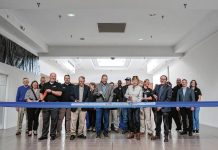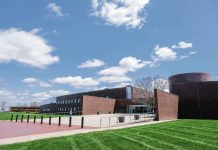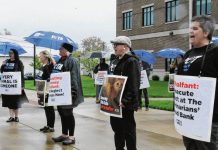The mission of the Mill Race Marathon is simple: Promote a lifestyle of health, both physically and nutritionally.
And luckily for the marathon planning committee, most organizations in Columbus share that philosophy.
But marathon organizers also know that it takes the efforts of an entire community to see a society permeated with healthy choices. That is why proceeds from the Mill Race Marathon each year are donated to two local health organizations.
In 2013 and 2014, Columbus Regional Health’s Reach Healthy Communities and the Columbus Park Foundation each received $40,000 to put toward health and wellness initiatives in the community.
[sc:text-divider text-divider-title=”Story continues below gallery” ]
The Park Foundation last year put half of its money into a pool of funds reserved for expansion of the People Trails, said April Williams, its project and resource development manager.
The remaining $20,000 was used to purchase barricades, which were then donated to the Columbus Parks and Recreation Department.
In 2013, the entire $40,000 was put toward People Trails expansion projects, Williams said.
“This improves the quality of life for our community,” she said. “We want to create a built environment to encourage better health in our community, and any new recreational asset that we add improves the quality of life in our community and draws people in.”
Suggestion box
People Trails users already have ideas of how the money could be used to improve the local trail systems.“The water situation is my biggest issue,” said Deb Roese, a Columbus resident who said she uses the trails at least once a week.It’s hard to find places to stop for water along the trail system because many of its legs are disconnected, Roese said.
If the trails had one central water location or opportunities to get water on each leg, Roese said, her exercise experience would be much better.
“Long term, I’d like there to be better lighting for when we’re biking after dark. But right now, water is my immediate need,” she said.
While most Columbus residents know the People Trails exist, Tricia Gruwell — who uses the trails multiple times a week — said it’s sometimes hard to find the beginning of the trails’ different portions.
“I accidentally stumbled upon the new entrance over by the jail,” Gruwell said. “It would help if it were more obvious.”
Fueling interest in food
For its part, Reach Healthy Communities chose to put all of its 2014 money toward starting or expanding a school gardens program at Columbus Signature Academy-New Tech, Columbus East High School and Parkside Elementary, director Beth Morris said.“There’s really some compelling research that shows how school gardens have sort of a triple benefit in terms of when kids are involved in growing food,” Morris said.The first benefit, Morris said, is that students are much more likely to experiment with healthier foods if they’ve grown it themselves.
Second, tending to a garden gets students moving and increases their physical activity, she said.
Finally, growing a garden teaches math and science lessons in an engaging way, which makes learning fun.
“They learn to measure and weigh. They learn botany. So there are all sorts of ways to enhance the educational lessons that can incorporate the real-life, hands-on learning that BCSC is so good at,” Morris said.
Just a month into the new school year, local students already are starting to experience all three of the benefits associated with school gardens.
As part of an environmental studies class at CSA-New Tech, students are learning to cultivate land, pull weeds, harvest seeds and manage an irrigation system.
“This is the first time that I’ve really been introduced to growing things,” said Alex Taylor, a CSA-New Tech freshman.
The CSA-New Tech garden began in 2008 and has since expanded into an area that includes fruit, vegetables, other plants and a water reservoir, partially with the assistance of Reach Healthy Communities.
Morris said she hopes to expand the school garden program to Flat Rock-Hawcreek schools this year, as well as to local private schools.
Funding food study
Reach Healthy Communities also used its 2013 money to enhance nutritional health, but for adults instead of children.About $30,000 of that year’s grant was used to support and fund various hunger and food organizations in the community, Morris said.In an effort to address hunger in Bartholomew and Jackson counties, the organization contracted with Ken Meter, president of Crossroads Resource Center in Minneapolis, to conduct a food study in the two counties.
While official results of the 2014 study likely won’t be published until October, Morris said, the study focuses on the positive effects of agriculture on overall food and financial security.
“It talks about how much revenue comes into Bartholomew and Jackson county for various produce and animal products,” Morris said. “It also talks about how much more money we could generate for local growers if buyers in the county bought from local sources more often.”
Similarly, Morris said Reach Healthy Communities partnered with the Purdue Extension to map out where local food producers and buyers are located in the area to match buying and selling needs.
Morris’ group also used its money to support local food-insecurity efforts.
The remaining $10,000 was put toward the creation of a pilot farmers market initiative, Morris said.
That program seeks to double the value of SNAP vouchers — previously known as food stamps — at local farmers market, which would enable SNAP participants to purchase $2 worth of food for only $1.
“That’s looking very promising,” Morris said.
With this year’s farmers market season about to end, that initiative would likely begin next year, she said.
Bike-share interest
In keeping with the marathon spirit of health and wellness, Williams and Morris say they are already discussing using proceeds from this year’s marathon to help fund a Columbus bike-share program.“It really complements what the committee tries to do with the race in terms of getting people to be more active,” Morris said.Williams said she has worked with the Indianapolis Cultural Trail and Pacers Bike-share team to evaluate how a bike-share program might work in Columbus.
Public surveys are being used to determine a level of interest in a bike-share program, Williams said.
In an already bicycle-friendly community, Williams believes Columbus is a perfect fit for a bike-share program.
“We want to look at what the best and most logical program would be,” Williams said. “We want to reduce our carbon footprint, do some bike infrastructure development, make the city safer for bikes and encourage more tourism.”
The amount of this year’s grants to the two organizations won’t be finalized until after the marathon.
But regardless of the amount, both women said they are grateful for the support of the marathon committee.
“It provides significant additional resources to expand our reach and impact,” Morris said.
Beyond financial assistance, Williams said, the marathon money is good for all of Columbus because it helps create a healthier city.
“Our goals coincide,” she said. “It just makes sense.”
[sc:pullout-title pullout-title=”Coming Monday” ][sc:pullout-text-begin]
With about a month to go before the third annual Mill Race Marathon, close to 100 volunteers are needed to help staff two days of events on Sept. 25-26. Find out what’s available and how you can apply in Monday’s edition of The Republic.
[sc:pullout-text-end][sc:pullout-title pullout-title=”Inside” ][sc:pullout-text-begin]
Having lost 168 pounds, a healthier Jennifer McCleary is ready to run her second half-marathon. See The Rundown in Sports, Page XX.
[sc:pullout-text-end]




